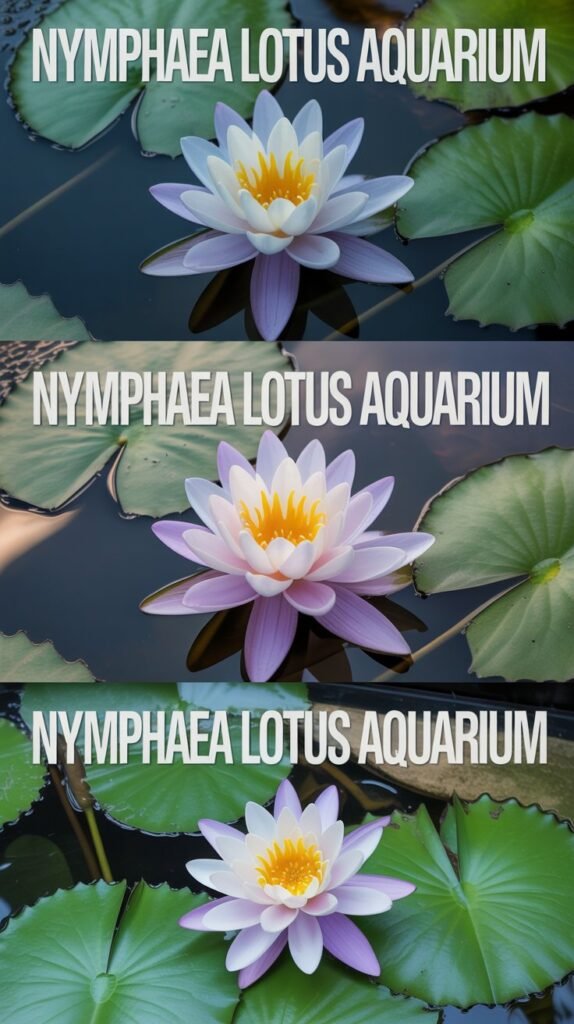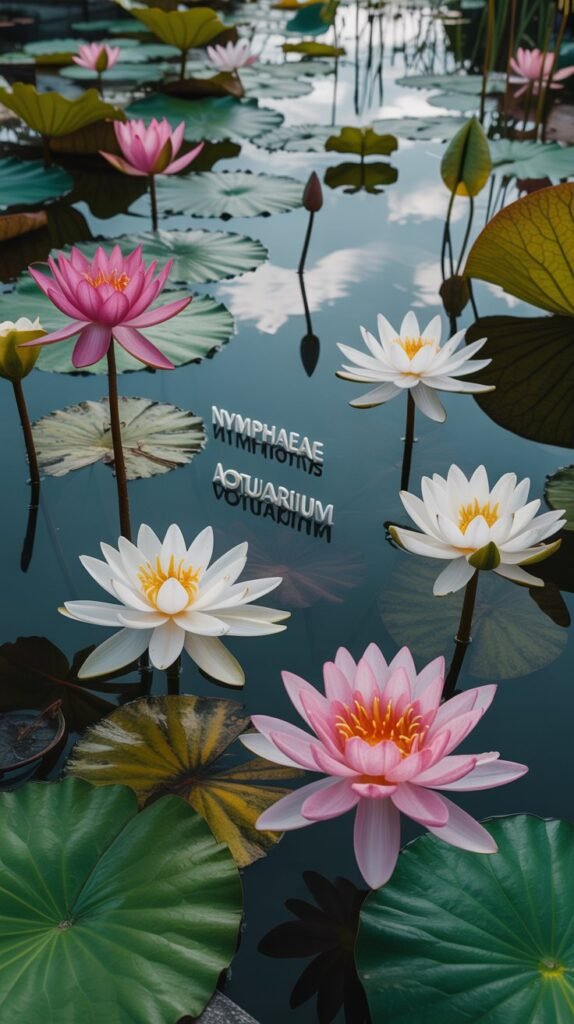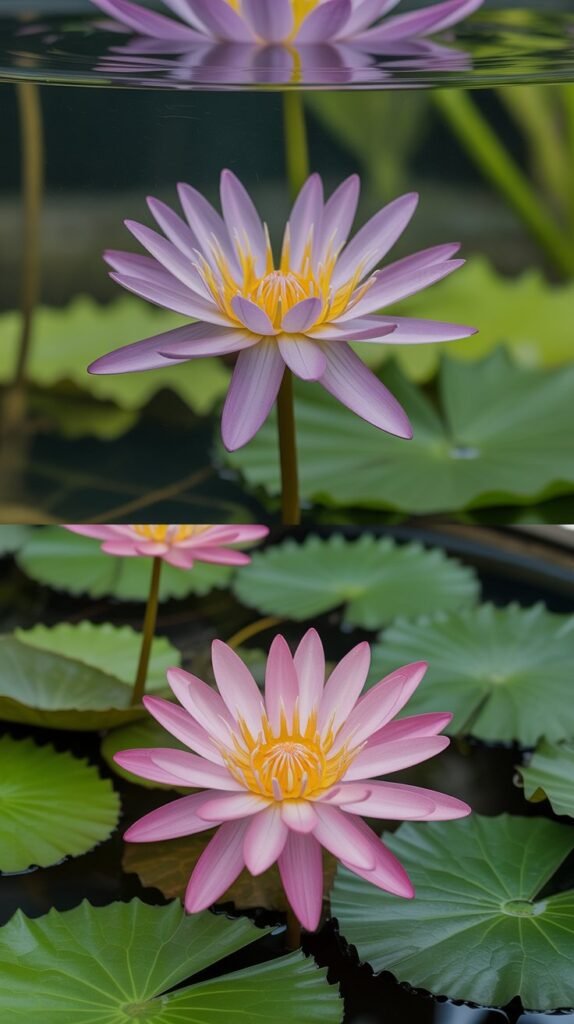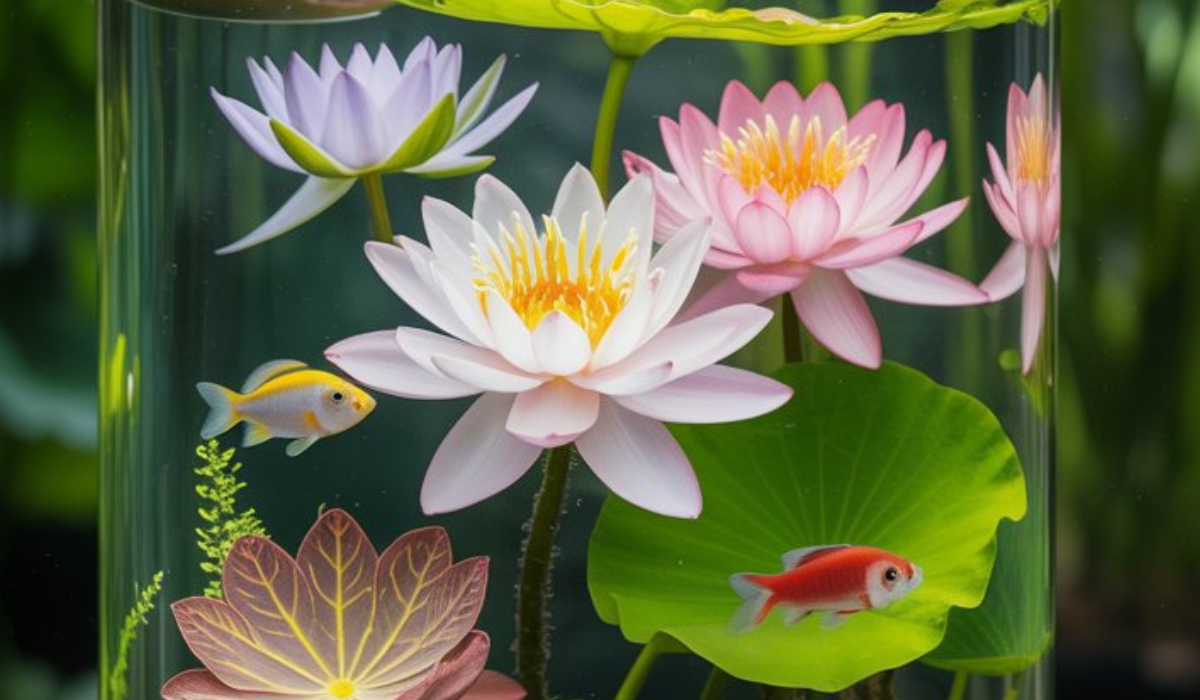When it comes to breathtaking aquatic plants that instantly elevate the beauty of an aquarium, few species can match the elegance of the Nymphaea Lotus. Often referred to as the Egyptian Water Lily, this stunning plant adds a sense of tranquility and natural luxury to any aquatic setup. Its broad leaves, mesmerizing color variations, and unique floating nature make it a centerpiece in both aquariums and aquascapes.
In this complete guide, we’ll explore everything you need to know about the Nymphaea Lotus aquarium — from its origin and types to lighting, planting techniques, care, propagation, and compatibility with fish.
What Is Nymphaea Lotus?
The Nymphaea Lotus is a species of aquatic plant belonging to the Nymphaeaceae family. It is native to tropical regions of Africa and Southeast Asia, commonly found in slow-moving rivers, ponds, and shallow lakes.
Known for its beautiful floating leaves and occasional fragrant flowers, the Nymphaea Lotus has become a popular plant among aquarium enthusiasts worldwide. It is admired not only for its ornamental appeal but also for its ecological benefits, such as oxygenation and water filtration.

In aquarium setups, it’s often seen as a background or centerpiece plant, bringing both height and drama to aquascapes.
Scientific Classification
| Category | Details |
|---|---|
| Scientific Name | Nymphaea lotus |
| Common Names | Egyptian Water Lily, White Lotus, Red Tiger Lotus (variant) |
| Family | Nymphaeaceae |
| Origin | Africa, Southeast Asia |
| Type | Bulb-based aquatic plant |
| Growth Rate | Moderate to Fast |
| Placement | Midground to Background |
| Lighting | Medium to High |
| CO₂ Requirement | Optional but beneficial |
| Temperature Range | 22°C–28°C (72°F–82°F) |
| pH Range | 6.0–7.5 |
| Hardness | 3–15 dGH |
Why Add Nymphaea Lotus to Your Aquarium?
Adding Nymphaea Lotus to your aquarium offers more than just visual appeal. It creates a dynamic aquatic ecosystem that benefits both plants and fish. Here’s why it’s a top pick among aquascapers:
1. Stunning Visual Appeal
The Nymphaea Lotus is known for its large, heart-shaped leaves that can display a wide range of colors — from green and bronze to deep red. The plant’s graceful floating leaves give the aquarium a natural and peaceful ambiance.
2. Natural Water Purifier
Like all live plants, it helps in absorbing excess nutrients like nitrates and phosphates, reducing algae growth and maintaining cleaner water.
3. Provides Shade and Shelter
The broad leaves of Nymphaea Lotus offer shade to smaller fish and shrimp, helping reduce stress and providing safe spaces for fry (baby fish).
4. Oxygenates the Water
As part of the photosynthesis process, it releases oxygen, improving overall tank health.
5. Perfect for Aquascaping
Its unique growth form — a mix of submerged and floating leaves — makes it ideal for creating depth and contrast in planted aquariums.
Different Varieties of Nymphaea Lotus
The Nymphaea genus includes many species and variants, but in aquariums, the most popular are:
1. Red Nymphaea Lotus (Nymphaea zenkeri)
Commonly known as the Red Tiger Lotus, this variant is loved for its reddish or copper-toned leaves with dark spots. It’s ideal for adding bold color contrast to green aquascapes.
2. Green Nymphaea Lotus
This variant features vibrant green to light brown leaves. It grows slightly faster and is excellent for natural-themed aquariums.
3. White Egyptian Lotus
This type can produce stunning white or pale pink flowers if allowed to grow above the water surface, typically in open-top tanks or ponds.
Setting Up a Nymphaea Lotus Aquarium

Creating the right environment ensures your Nymphaea Lotus grows strong, healthy, and vibrant.
1. Tank Size
This plant grows quite large, so it’s best suited for medium to large tanks (20 gallons or more). A spacious tank allows for proper root spread and prevents overcrowding.
2. Substrate
Being a root-feeding plant, Nymphaea Lotus thrives in:
- Nutrient-rich substrate (like ADA Amazonia, Tropica, or Fluval Stratum)
- Alternatively, fine gravel or sand with root tabs added every few weeks.
When planting, ensure the bulb is only half-buried. Burying it completely can cause rot.
3. Lighting
Nymphaea Lotus grows well under medium to high lighting. The intensity of light affects both growth rate and coloration:
- Moderate light = green to bronze leaves.
- High light = deep red or purple hues.
Aim for 8–10 hours of light daily using LED aquarium lights.
4. Water Parameters
Maintain the following stable conditions:
- Temperature: 22–28°C (72–82°F)
- pH: 6.0–7.5
- Hardness: Soft to moderately hard water (3–15 dGH)
- Flow: Gentle to moderate (avoid strong currents)
5. CO₂ and Fertilization
While Nymphaea Lotus can survive without CO₂, it benefits significantly from supplementation:
- CO₂ Injection: Enhances leaf size and coloration.
- Fertilizers: Use iron-rich fertilizers and root tabs to promote vibrant color and healthy root development.
How to Plant Nymphaea Lotus
Planting the Nymphaea Lotus correctly is key to its long-term success.
Step-by-Step Planting Guide
- Prepare the Bulb:
Choose a firm, healthy bulb. Avoid any that feel mushy or smell rotten. - Position the Bulb:
Place it on the substrate surface and gently push it halfway in. Leave the top half exposed to prevent rot. - Anchor if Needed:
If the bulb floats, use a small rock or decoration to keep it in place until roots develop. - Initial Growth:
Within 1–2 weeks, you’ll see shoots emerging. Once established, it anchors itself firmly.
Growth Patterns and Behavior
Nymphaea Lotus grows both submerged and floating leaves.
- Submerged Leaves: Shorter, broader, and stay underwater — perfect for aquascaping.
- Floating Leaves: Longer stems that reach the surface — they can shade other plants if left untrimmed.
To maintain control and aesthetics:
- Trim floating leaves to promote compact underwater growth.
- Regular pruning also encourages new leaves and prevents light blockage.
Maintenance and Care Tips

Although easy to care for, consistent maintenance ensures long-term beauty and balance.
1. Prune Regularly
Cut older or surface-reaching leaves close to the base. This encourages new growth and prevents surface overcrowding.
2. Monitor Nutrient Levels
Yellow or pale leaves indicate nutrient deficiencies — usually a lack of iron or potassium. Use targeted liquid fertilizers to correct this.
3. Control Algae
High lighting and nutrient levels can lead to algae buildup on leaves. To manage this:
- Reduce light intensity or duration.
- Add algae eaters like Amano shrimp or Nerite snails.
4. Perform Water Changes
Weekly 20–30% water changes help prevent nutrient imbalances and keep the water clean.
5. Watch Growth Rate
Under ideal conditions, this plant can grow quickly. Trim as needed to prevent it from overtaking your aquarium.
Propagation of Nymphaea Lotus
Propagation is one of the most rewarding aspects of keeping Nymphaea Lotus.
1. Bulb Propagation
As the plant matures, it produces daughter bulbs beside the main bulb. Once these small bulbs develop roots and leaves:
- Separate them carefully from the parent plant.
- Replant them halfway into the substrate in another area.
2. Seed Propagation
In open-top tanks or ponds, Nymphaea Lotus can produce flowers that release seeds. The seeds can germinate in warm, shallow water, although this process is rare in enclosed aquariums.
Tank Mates for Nymphaea Lotus
This plant is peaceful and compatible with most community fish. It creates a natural shelter and enhances habitat diversity.
Best Tank Mates
- Guppies
- Tetras (Neon, Cardinal, Ember)
- Rasboras
- Angelfish
- Gouramis
- Shrimp (Amano, Cherry)
- Snails (Nerite, Mystery)
Avoid
- Goldfish (they uproot and eat plants)
- Large Cichlids (can damage delicate leaves)
- Plant-eating species like Silver Dollars
Common Problems and Solutions
| Problem | Cause | Solution |
|---|---|---|
| Bulb Rotting | Bulb fully buried | Keep top half exposed |
| Leaves Turning Yellow | Iron deficiency | Add iron fertilizer |
| Excess Floating Leaves | Too much light/nutrients | Trim and control growth |
| Algae Growth | Excess light or nutrients | Reduce lighting; add algae eaters |
| Slow Growth | Low nutrients or cold water | Increase fertilizer and maintain temperature |
Nymphaea Lotus in Aquascaping
The Nymphaea Lotus is a favorite centerpiece plant in professional aquascapes. Its large, dramatic leaves create texture and depth, while its color contrast enhances natural beauty.
Best Aquascaping Ideas
- Centerpiece Layout: Place it slightly off-center for visual balance.
- African Biotope Aquariums: Ideal for recreating natural African river systems.
- Nature Aquariums: Combine with fine-leaved plants like Rotala or Ludwigia for contrast.
- Minimalist Setup: A single Nymphaea Lotus can transform a simple aquascape into a stunning focal point.
Benefits of Nymphaea Lotus in an Aquarium
- Natural Filtration: Absorbs waste nutrients, keeping the tank clean.
- Improves Oxygenation: Enhances water quality for fish and plants.
- Aesthetic Appeal: Adds elegance and color contrast.
- Provides Shade: Reduces stress for shy or light-sensitive fish.
- Promotes Biological Balance: Stabilizes the aquarium ecosystem.
Red vs. Green Nymphaea Lotus
| Feature | Red Nymphaea Lotus | Green Nymphaea Lotus |
|---|---|---|
| Leaf Color | Deep red, marbled patterns | Bright green to bronze |
| Lighting Needs | High | Medium |
| Growth Rate | Moderate | Fast |
| Visual Impact | Bold and dramatic | Natural and subtle |
| Best For | Focal plant | Background plant |
Both varieties are stunning — choosing between them depends on your desired aquascape theme.
Buying and Selecting Nymphaea Lotus
When buying, look for:
- Firm bulbs (not soft or slimy)
- Healthy leaves without holes or rot
- No pest presence like snails or algae
You can purchase it from:
- Local aquarium shops
- Online plant retailers (like BucePlant, Aquarium Co-Op, or AquaHabitats)
- Aquatic plant hobbyist groups
Safety and Compatibility Tips
- Avoid copper-based medications — toxic to plants and shrimp.
- Quarantine new plants to prevent introducing pests.
- Ensure adequate space — large leaves can quickly shade smaller plants.
Conclusion
The Nymphaea Lotus is one of the most enchanting and rewarding plants you can keep in your aquarium. Its blend of beauty, resilience, and functionality makes it a must-have for aquascapers and plant enthusiasts alike.
With proper lighting, nutrient-rich substrate, and regular maintenance, your Nymphaea Lotus aquarium will flourish — offering a captivating underwater landscape that combines elegance with natural balance.
Whether you’re creating a serene nature tank or a vibrant aquascape centerpiece, this plant never fails to impress.
Frequently Asked Questions (FAQs)
1. Is Nymphaea Lotus suitable for beginners?
Yes. It’s easy to grow and adaptable to various conditions, making it beginner-friendly.
2. How big does Nymphaea Lotus get?
It can reach 12–20 inches (30–50 cm) in height, depending on tank conditions.
3. Can I grow Nymphaea Lotus without CO₂?
Yes, but adding CO₂ will enhance growth rate and color vibrancy.
4. Why is my Nymphaea Lotus bulb rotting?
You likely buried it too deep. Keep the bulb half-exposed to prevent rot.
5. How do I encourage red coloration in the leaves?
Provide strong lighting and iron-rich fertilizers.
6. Does Nymphaea Lotus flower underwater?
It can, but most flowers bloom above the surface in open-top aquariums or ponds.
7. How often should I trim Nymphaea Lotus?
Trim surface-reaching leaves weekly to maintain a balanced aquascape.
8. What fish species are best with Nymphaea Lotus?
Peaceful community fish like Tetras, Guppies, and Rasboras are ideal companions.
9. Can it survive in low light?
Yes, but it will grow slower and maintain green coloration instead of red.
10. How long does the bulb last?
With proper care, the bulb can last years, producing new plants seasonally.

